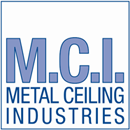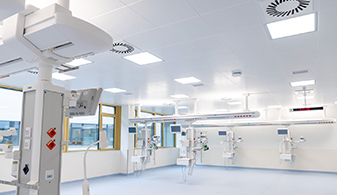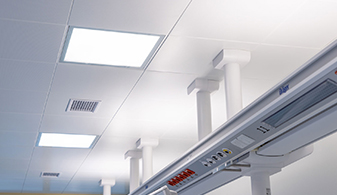Cleanroom hygiene ceiling system
A cleanroom hygiene ceiling system is specifically designed for controlled environments where high air purity is required, such as in the pharmaceutical industry, electronics manufacturing, or medical technology. These ceilings are made from smooth, easy-to-clean materials that prevent dust accumulation and are anti-static. The elements are airtight and often modular, making it easier to integrate filters, lighting, or ventilation systems.
Features & Benefits:
-
Particle Control: Cleanroom hygiene ceilings prevent the entry and release of particles that could compromise the purity of the environment. This is critical for maintaining the particle count in the air at very low levels, as required in cleanrooms.
-
Sterile and Hygienic Surfaces: The smooth, non-porous surface of a cleanroom hygiene ceiling minimizes the possibility of dust, bacteria, and other contaminations accumulating.
-
Easy Integration of Technical Components: Cleanroom hygiene ceilings can easily be equipped with essential technical systems like ventilation units, lighting, sensors, and other devices needed for controlling and monitoring the cleanroom. This facilitates the installation and maintenance of cleanroom technology, improving the functionality of the space.
-
Modularity and Flexibility: Many cleanroom hygiene ceilings are modular, meaning they can be easily dismantled or reconfigured without contaminating the cleanroom. This allows for easy adaptation to changing requirements or technical maintenance, increasing the flexibility of cleanroom design.
-
Pressure and Tightness Properties: Cleanroom hygiene ceilings help maintain the required pressure conditions (positive or negative pressure) within the cleanroom, ensuring airflow control and preventing particle migration. The sealing of the ceiling prevents the infiltration of particles and air from outside, securing the integrity of the cleanroom environment.
-
Reduction of Energy Costs: By efficiently controlling airflow and using filters, the cleanroom hygiene ceiling contributes to energy efficiency. Well-insulated ceilings can minimize heat loss, reducing the need for additional air conditioning.
-
Fire Resistance and Safety: Cleanroom hygiene ceilings are often fire-resistant and comply with fire safety regulations, enhancing safety in the event of a fire. This reduces the risk of property damage and personal injury, improving the overall safety record of the cleanroom.
-
Improved Working Conditions: Cleanroom hygiene ceilings can provide acoustic insulation, helping to reduce noise levels in the cleanroom. This contributes to a more comfortable and productive working environment, especially in noisy production areas. The integration of specifically tailored lighting creates optimal working conditions for precision tasks.
-
Durability and Easy Maintenance: Cleanroom hygiene ceilings are made from durable materials resistant to corrosion, chemicals, and cleaning products. This minimizes the need for frequent maintenance or replacements. Maintenance is straightforward, as many systems offer modular designs, allowing parts to be easily swapped out or repaired without disrupting the cleanroom operation.
-
Compliance with Cleanroom Standards: Cleanroom hygiene ceilings help ensure compliance with strict international cleanroom standards and norms (e.g., ISO 14644), guaranteeing the quality and safety of products and processes.
Overall, a cleanroom hygiene ceiling offers significant benefits for maintaining a controlled, clean, and safe environment, which is essential for many industries.



